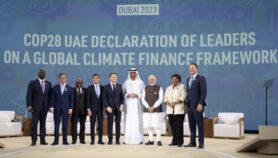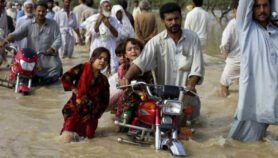By: Rasha Dewedar
Send to a friend
The details you provide on this page will not be used to send unsolicited email, and will not be sold to a 3rd party. See privacy policy.
[CAIRO] People living in countries around the Arabian Sea have been exposed to tropical cyclones that have been growing in strength since 1997, and hitting the area earlier than usual — but scientists are still debating what is driving these changes.
A study published in Nature last month (20 September) challenges previous conclusions that the stronger cyclones are being driven by man-made pollution, such as aerosol and sulphate emissions.
Instead, it claims, the stronger cyclones are caused by an earlier onset of the Asian summer monsoon, which in turn may be driven by natural variation or man-made warming.
But the authors of the original paper, published in Nature in November 2011, reject the new findings and maintain that pollution is the fundamental cause.
Over the past 60 years, the Arabian Sea has been exposed to huge growth in emissions from the Indian subcontinent.
The 2011 study, led by Amato Evan, an assistant professor at the Scripps Institution of Oceanography, United States, attributed the intensification of tropical cyclones since 1997 to this simultaneous upward trend in black carbon and sulphate emissions.
But Bin Wang, chair of the meteorology department at the University of Hawaii’s International Pacific Research Center, United States, and collaborators in China, instead attribute the increase to the early onset of the Asian summer monsoon.
The genesis of tropical cyclones requires favourable environmental conditions, and Wang argues these are fulfilled by earlier monsoons which then shape the winds and affect the cyclone formation.
The monsoon’s earlier arrival itself may be caused by a higher temperature difference between Asian landmass and equatorial Indian Ocean, which may stem from natural variation on a decadal scale, or man-made warming, Wang’s study says.
Thus Wang’s findings suggest that the reasons behind tropical cyclones intensifying are, in fact, related to natural variability, rather than pollution, such as that posited by Evan and his team.
Either way, the enhanced storm severity poses significant risks for local communities.
"The pre-monsoon tropical cyclone intensification will bring more disastrous weather with [it], especially for countries surrounding the Arabian Sea", Wang said.
Ashraf Zakey, director-general of scientific research at the Egyptian Meteorological Authority, said that the earlier monsoon onset cited by Wang as the cause of cyclone severity is the result of global warming caused by increasing pollution emissions.
"The scientists are observing faces of the same coin," said Zakey, who added that further studies are needed to unveil the cause of this phenomena.
References
Nature doi:10.1038/nature11471 (2012)
Nature doi:10.1038/nature11470 (2011)













